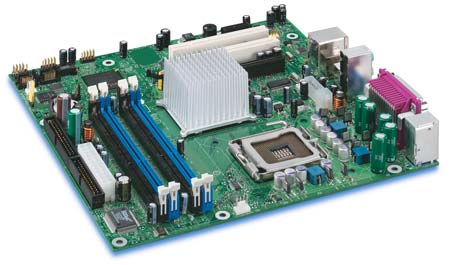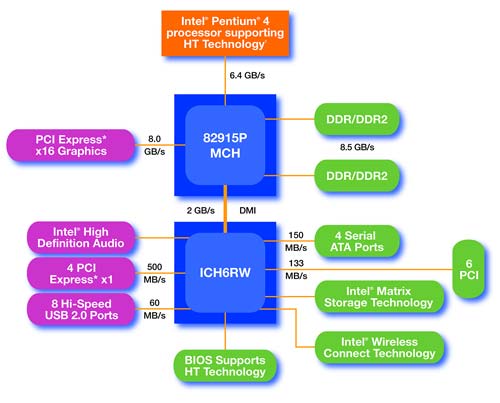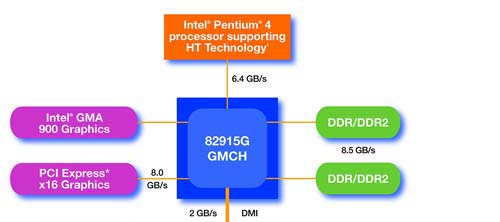Intel 925X/915: Chipset Performance & DDR2
by Wesley Fink on June 19, 2004 3:01 AM EST- Posted in
- CPUs
Intel 915G Express
Intel also provided a D915GUX motherboard for evaluation.
The 915 chipset comes in several flavors, both with and without the new Intel integrated graphics.

Most mainstream boards geared to AnandTech readers will feature the 915p chipset, without integrated graphics. The chipset is essentially a 925X without the acceleration technology, but with the added option of using either DDR or DDR2 memory, depending on what memory support the manufacturer chooses to provide. Other options are provided by the Southbridge and depend on which ICH6 version is paired with the 915P.

915G offers the same options as 915P, but adds Intel's integrated graphics. Intel has significantly upgraded integrated graphics for the 915 chipset, and now support DirectX 9 and OpenGL 1.4 on their integrated graphics. The new solution is called "Intel Graphics Media Accelerator 900". Intel claims that performance is doubled over Intel Intense Graphics 2. AnandTech takes a closer look at the performance of the new Intel integrated Graphics in the review of the Socket 775 CPU launch and PCIe Graphics that is the companion to this article. There is also an economy version of the 915 called 915GV, with integrated Media Accelerator 900 graphics, but without a PCIe 16X graphics card slot. We suspect that the 915GV will become a favorite of the Corporate desktop.

The D915GUX that we evaluated had all of the 915 features in a micro ATX form factor. Despite the smaller size, the D915GUX still provides integrated graphics, plus a PCIe 16X graphics slot, a PCIe 1X slot, and 2 PCI slots. All of the Intel boards, even the 915gux, provide 4 DIMM slots and support up to 4GB of memory. Please also notice that a 24-pin power connector, and not a 20-pin, is also a feature of 915 boards. 20-pin is backwards compatible, however, and the 24-pin is keyed to accept a standard 20-pin connector on one side of the new 24-pin.










57 Comments
View All Comments
Mike89 - Saturday, June 19, 2004 - link
This is a real shake up to me. I mean this is no small change that Intel wants everyone to do. And for what? The only thing that comes to mind is "just so I can say I did it". Makes no sense at all for me. Intel shouldn't have put this out until they could show it was really worth it. I don't see it in any kind of way. And with all this, they STILL can't beat AMD (in gaming anyway). This looks more like a power grab than anything else, another way to make more money for Intel. I'm not one bit impressed or interested.Anemone - Saturday, June 19, 2004 - link
Thank you Anand for giving us the real deal on these new things. I'd love to say different, but AMD is too pricey and Intel performance is pathetic, and their prices, most especially when you consider the insane cost of DDR2, are no better."in 2005 we'll be better" Yeah right. AMD performs great till you give it too much to do at once, and they won't fix that till they bring in dual core. And if you think they'll manage that in 2005... yeah right on that too. AMD will be lucky to even SEE production chips on 90nm in 2005.
Don't think Intel has some great recovery coming either. The 925/915 release and the costs that they want to charge for chips that don't perform, is ludicrous. Yeah they multitask, but they can't do anything much better than systems could a year ago. Dual core might be coming, but it seems clear they have to change a lot of things to do it so why even create the 9XX chipset? This thing is going the way of the 820, from day 1.
If I'm not paying $800 for a chip that DOES perform, what on earth makes Intel thing I'm goign to spend $700 for the new 3.6 or worse $850-1000 for a chip that can barely keep up with that $800 chip? I know what makes you think that, arrogance. It's not desperation yet, but that's what it's going to become soon.
I'm disappointed in all sides of this. But I'm grateful Anand put it in a clear and honest light.
mostlyprudent - Saturday, June 19, 2004 - link
I agree with the comment toward the end of the article regarding Intel's ability to make things fall into place. Remember how disappointing the first itterations of the P4 were...Remember how dismal Prescott's performance was when first released? 2 years ago I bought a cutting edge system only to watch intel up the FSB from 400 to 533 to 800mhz, introduce 875/ICH5R and see SATA mature into the better hard drive option (see Anantech's Q2 hard drive round up), all within about a year. So I am glad to see Intel introducing a range of features all at once instead of changing the socket, then adding a new chipset a little later then a few months later revising the southbridge and so on. For those of us who do not have limitless upgrade budgets it is painful to see new features and chipsets added on what seems like a monthly basis.Of course I'm still planning on making the switch to A64 in the very near future.
SLIM - Saturday, June 19, 2004 - link
The funniest part of all of this benchmarking is that you STILL cannot buy a 3.4g prescott on pricewatch for any chipset (4.5 months after launch). People bickering about using the FX53 (launched earlier this month and widely available NOW) for comparison purposes should do a quick reality check and know that the Anandtech guys tried to show Intel in the best light they could... Raid for 925X vs. mid range seagate for AMD, wrong timing on AMD memory (wasn't it AT who said 2-2-2-10 was best performance), etc.Good review overall as usual for AT; looking forward to the upcoming, more indepth comparison.
AtaStrumf - Saturday, June 19, 2004 - link
The new chipset appears to be faster, but the CPU and DDR II appear to be a bit slower, so in the end it preety much evens out, with one BIG difference: PRICE.It is now very obvious why AMD is in no hurry to go PCIe or DDR II, but once this picks up AMD will have to play catch up again. Not great, but probably better than having to be the one to break the ice.
Today also seems to be the birth of the new naming scheme, and the 5 that prescott has gotten tells me we will be seing something more potent with the 7 in the name. That is in fact the point of these new names, since prescotts will get higher frequences, but not much more performance.
I'm much more excited about those CPUs than prescotts, which were DOA anyway. Franky I'm surprised it's doing as good as it is.
So if you dont't have performance to sell, what do you do? You sell features, which are the only good thing that this new chipsets brings for early adopters, with the notable exception of a single IDE, but as Gigabyte has shown, that is really not the problem. They just added an extra chip for that, just like it was with SATA in the early days, only now the roles are reversed.
Bozo Galora - Saturday, June 19, 2004 - link
thanx for quick reply and clearing that up wesley. you da man - I remember you from abxzone.Always thourough and focused - just like a Benihana chef.
Pandaren - Saturday, June 19, 2004 - link
29 - TrueWisdomPrescott might have been designed with 4-5 GHz in mind, but it's already dissipating 115 watts at 3.6 GHz. The Pentium 4's of yesteryear at least had potential for good scaling. Prescott has fallen flat on its ass as far as scaling is concerned.
When I think about it, this review isn't so much of a reflection of the awfulness of the 900 series chipsests as a reflection of the mediocrity of the Prescott Pentium 4.
tart666 - Saturday, June 19, 2004 - link
woo-hooo, NCQ for the masses! that alone is worth the upgrade...TrueWisdom - Saturday, June 19, 2004 - link
Well, while it is certainly disappointing to see that Intel's "hardware revolution" doesn't really do much at all, but I can't help but think about AMD two years back, when the AMD XP line was getting trounced by Intel's Northwood line. This sort of thing happens to companies, and I think that it's unfair to immediately say: "Intel is losing it."I think the biggest thing to remember about Intel is that they've always been convinced that clock speed is the way to go. That's why they're pushing this new standard so heavily: not because they think it will perform better at current speeds, but because they can push all of the speeds so much farther. (This was essentially the same thing that they did with the launch of the P4, and I'd say that ended up being all right.)
PCI Express allows for SO much more bandwidth that it would be silly not to adopt it, DDR2 can be pushed a hell of a lot farther than DDR1, and we already know that the Prescott was designed with 4 and 5 GHz models in mind. Is Intel's approach the right one? Maybe, and maybe not, and they certainly don't have the right to try and flip the industry on its head with so little immediate performance gains. But, they did it before with the P4, and after two years it became the clear dominator of the market, until AMD finally got the A64 out the door. So, while I totally agree that there's no need to upgrade now, that's no reason not to be excited for the future: look how far the P4 came, and look where it started.
Wesley Fink - Saturday, June 19, 2004 - link
#26 - The Gigabyte board adds 2 additional IDE channels with a GigaRAID controller, plus it also has the single IDE channel provided by the chipset. The new chipsets only support one IDE channel, but manufacturers can add in other chips if they choose.